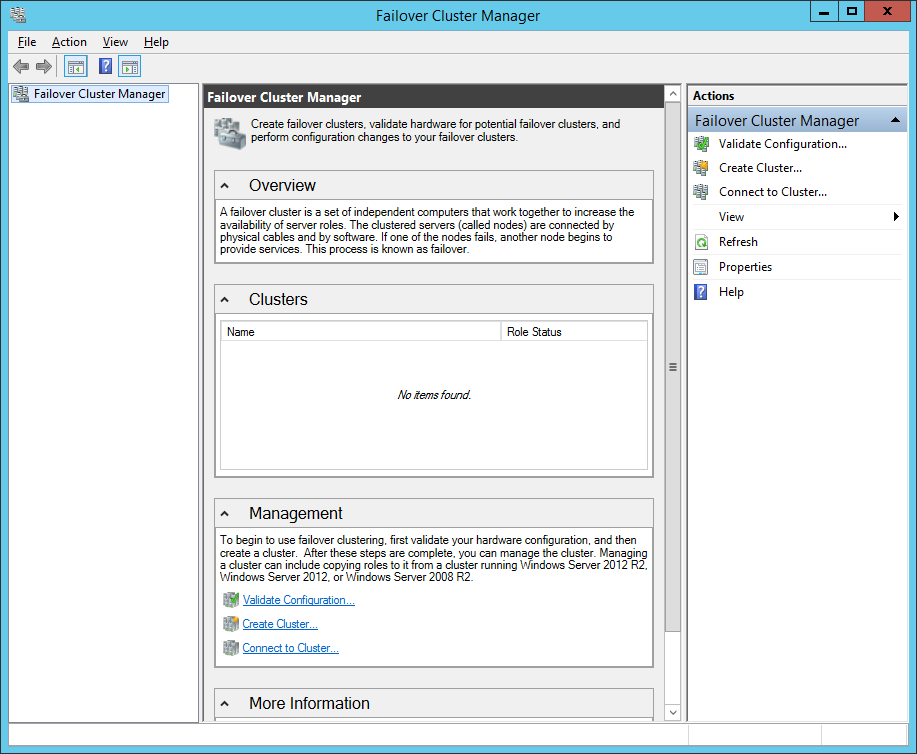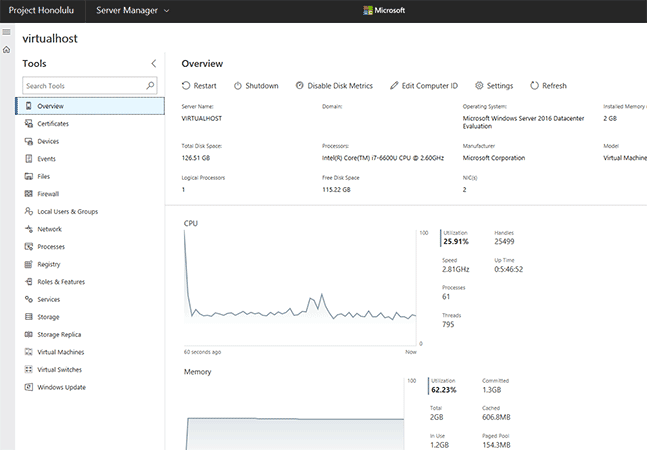Microsoft Failover Cluster Manager
- Microsoft Failover Cluster Manager 2016
- Failover Cluster Manager Roles
- Microsoft Failover Cluster Manager Roles
- Windows 2008 Failover Cluster
In some cases, it may be necessary to uninstall and reinstall the Windows Failover Clustering feature on a server that is currently a member of a Failover Cluster. This can be done via either Server Manager, or PowerShell. Below are the steps to complete the process using each method. These instructions document the process for Windows Server 2012 R2, however the steps are similar for other versions of Windows.
Uninstall the Windows Failover Clustering feature via Server Manager
Complete the following steps with a user account that has administrative rights over the cluster, from any server that has access to the cluster. If the desired server is not listed, first add it by clicking Manage > Add Servers in Server Manager.
- In this tip, I'll show you a few management tasks that may help the novice. Most tasks will be carried out using Failover Cluster Management which is the management console built into Windows Server 2008. You can access the Failover Cluster Management in a couple of different ways: Go to Server Manager, Features, Failover Cluster Manager.
- The following screenshot shows Failover Cluster Manager as you see it when it is opened for the first time: As with Hyper-V Manager, it is divided into three panes. The left pane is currently empty, but attached clusters will appear underneath the Failover Cluster Manager root node, in much the same fashion as Hyper-V Manager’ host display.
- To me, it looks like the workstation is trying to ask the server what services it provides, using WMI. DCOM cannot activate Windows Management Instrumentation (WMI) because it is blocked by a firewall.
AnilM in Windows Server 2016 Failover Cluster Troubleshooting Enhancements - Cluster Log on Could you please provide information on below as well. Meaning of state codes in cluster.logwhat are Cluster service sub-components available in WS 2016/2019 and what is the function of each sub-component in failover clusterThank you. Microsoft Download Manager is free and available for download now. Management Pack Guide for Failover Cluster.docx. Microsoft SC Management Pack for Cluster.CHS.msi.
- In the Nodes view of Failover Cluster Manager, right-click on the node where the Failover Clustering feature is being uninstalled, select More Actions > Evict, and wait for the node to be removed from the Nodes view.
- Open Server Manager and click Manage > Remove Roles and Features.
- If prompted, click Next on the “Before you begin” window.
- Select the server where the Failover Clustering feature is being uninstalled, and click Next.
- Click Next on the “Remove server roles” window.
- On the “Remove features” window, deselect the checkbox next to “Failover Clustering” and click Next.
- If prompted, deselect the checkbox next to “Remove management tools (if applicable)” to retain the Failover Cluster Management Tools and PowerShell modules, if desired, and click Continue.
- On the “Remove features” window, click Next.
- Select the checkbox next to “Restart the destination server automatically if required”, and confirm that the server will be restarted if required if prompted before clicking Remove.
- The server will be rebooted when the feature is successfully removed.
Install/reinstall the Windows Failover Clustering feature and add the node to a cluster via Server Manager and Failover Cluster Manager
Complete the following steps with a user account that has administrative rights over the cluster, from any server that has access to the cluster. If the desired server is not listed, add it by clicking Manage>Add Servers in Server Manager.
- Open Server Manager and click Manage>Add Roles and Features.
- If prompted, click Next on the “Before you begin” and “Select installation type” windows, then select the server on which the Failover Clustering feature is to be installed.
- Click Next on the “Select server roles” window.
- Select Failover Clustering on the “Select features” window, and click Next.
- If prompted, select the checkbox next to “Include management tools (if applicable)” to install the Failover Cluster Management Tools and PowerShell modules, if desired, and click “Add Features”.
- Select the checkbox next to “Restart the destination server automatically if required”, and confirm that the server will be restarted if required if prompted before clicking Install.
- The server will be rebooted when the Feature is successfully installed.
- When the reboot is complete, open Failover Cluster Manager, Click “Add Node”, and follow the instructions in the “Add Node Wizard” to add the node to a cluster.
Uninstall the Windows Failover Clustering feature via PowerShell

Complete the following steps from an elevated PowerShell prompt with a user account that has administrative rights over the cluster, from any server that has local or remote access to the cluster. If necessary, run the following commands first to import the Failover Clustering and Server Manager PowerShell modules:
Import-Module FailoverClusters
Import-Module ServerManager
Once the modules have been loaded or verified:
- Run the following command to evict the node where the Failover Clustering feature is being uninstalled:
Remove-ClusterNode -Cluster <clustername> <nodename>- Select Yes if prompted for confirmation.
- Run the following command to confirm that the desired node is not listed as a member of the cluster:
Get-ClusterNode -Cluster <clustername> - Run the following command to remove the Failover Clustering feature from and reboot the desired node:
Remove-WindowsFeature Failover-Clustering -ComputerName <nodename> -Restart
Install or reinstall the Windows Failover Clustering feature and add the node back to the cluster via PowerShell
Complete the following steps from an elevated PowerShell prompt with a user account that has administrative rights over the cluster, from any server that has local or remote access to the cluster. Toni braxton yesterday download. If necessary, run the following commands first to import the Failover Clustering and Server Manager PowerShell modules:
Import-Module FailoverClusters
Import-Module ServerManager
Microsoft Failover Cluster Manager 2016

Once the modules have been loaded or verified:
Failover Cluster Manager Roles
- Run the following command to remove the Failover Clustering feature from and reboot the desired node:
Install-WindowsFeature Failover-Clustering -ComputerName <nodename> -Restart - When the reboot is complete, run the following command to add the node back to a cluster:
Add-ClusterNode -Cluster <clustername> <nodename> - Run the following command to confirm that the desired node is listed as a member of the cluster:
Get-ClusterNode -Cluster <clustername>
Microsoft Failover Cluster Manager Roles
I hope you find this information useful. Happy clustering!
Windows 10 setup install. Download Windows 8.1 build 9385 Setup.exe. In Windows 8.1, Windows Blue Tutorials - on 4:47 PM - No comments. Windows 8.1 build leaks continues. Yesterday, a new Windows 8.1 build 9385 screenshots got leaked on the web. So far only images of the build running on a PC is public, and expect the ISO on P2P networks in next few days. Nov 05, 2013 Therefore, starting with the release of Windows Vista and continuing in Windows 8.1, the Windows Help program will not ship as a feature of Windows. If you want to view 32-bit.hlp files, you must download and install the program (WinHlp32.exe) from the Microsoft Download Center. Sep 16, 2019 I would suggest you to reset Windows Store Cache and check if it helps. A) Press 'Windows Key +R' on the keyboard to open Run Window. B) In the Run Window type wsreset.exe and then click OK. Method 3: If you have installed any third party security software, I would suggest you to uninstall it and then try to upgrade to Windows 8.1. May 05, 2014 Download Windows 8.1 Update for x64-based Systems (KB2919355) from Official Microsoft Download Center. Windows 8.1 Update for x64-based Systems (KB2919355) Important! Selecting a language below will dynamically change the complete page content to that language. Clearcompressionflag.exe, KB2919355, KB2932046, KB2959977, KB2937592. Apr 09, 2017 setup,exe for what? Setup.exe is a program written to install a particular program. They are all different because they are designed to do a particular job. As an example, the setup.exe on the Windows 10 DVD will install Windows 10. Usually all you need to do with a setup.exe file is run it.
Windows 2008 Failover Cluster
Eriq Stern
Support Escalation Engineer
Windows High Availability Team